
6 Tips for using the Vocab Analytics dashboard on Flocabulary
Analyzing data to drive instruction is an essential ingredient in transformational outcomes for learners, especially when it comes to literacy. 38 states (so far) have implemented Science of Reading legislation, cementing the vital role that evidence-based literacy instruction will play in how students are taught. Ensuring that all students have access to high-quality instruction is key to this nationwide endeavor, and access to the right tools and data supports the educators who deliver that instruction.
The Vocab Analytics dashboard within Flocabulary makes this high-quality, data-informed instruction possible. Deciding what and how to teach based on individual student data means that teachers are tailoring their teaching to meet student needs. At the district level, analyzing student data helps identify opportunities to drive high-quality instruction in every classroom and school building. Check out these tips both teachers and administrators can use to navigate and leverage the vocab analytics.
New to Flocabulary? Teachers can sign up for a trial to access our lesson videos and assessment activities. Administrators can get in touch with us to learn more about unlocking the full power of Flocabulary through Flocabulary Plus.
Flocabulary’s Vocab Analytics dashboard
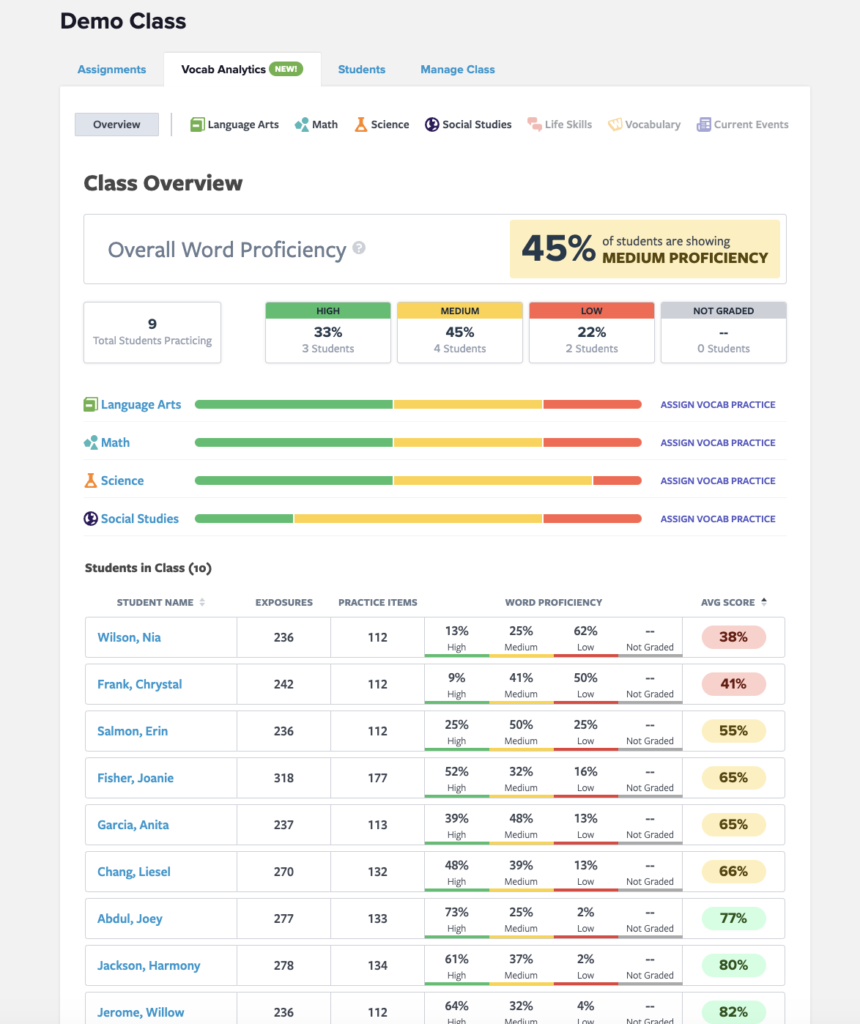
Flocabulary’s Vocab Analytics feature provides administrators and teachers with crucial insights into students’ vocabulary acquisition and comprehension. On the Analytics section of the homepage, you can view the average number of word exposures per student in your class, school, or district, as well as the number of words students have been exposed to. The U.S. Department of Education recommends 17 exposures to a vocabulary word to help students master that word (Bennett, 2019). You’ll also see how often students’ comprehension of vocabulary words has been explicitly assessed through word practice items like the Vocab Game, and the level of proficiency students are showing on these words based on their practice scores.
How to access Flocabulary’s Vocab Analytics dashboard
When administrators log into Flocabulary, a section on the homepage called “My Analytics” will be visible. Here, you’ll get a high-level view into how students in your district are progressing in vocabulary:
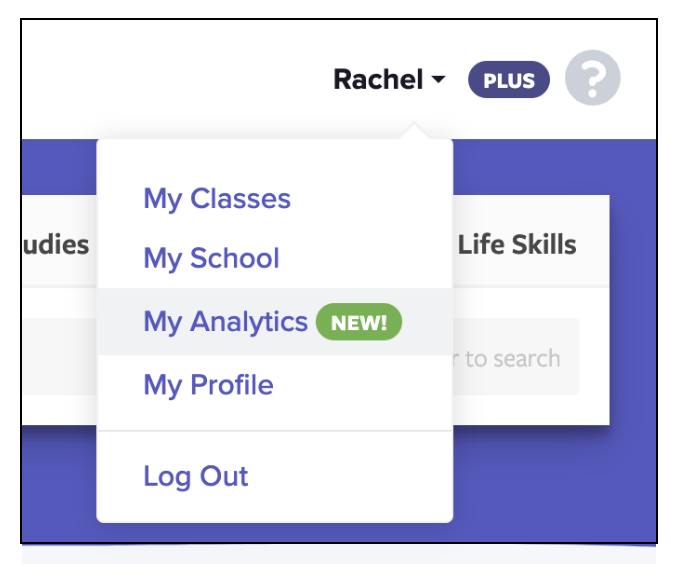
- Click “View All Analytics” or “My Analytics” under your name on the top right to access your analytics dashboard and dive deeper into the data.
- Select the school year or semester you’d like to dive into. The dashboard will default to showing data for the most recent school year with data.
- In the Analytics section, you can view the average number of vocabulary exposures and practice items per student in the district, as well as the percentage of students who are showing high, medium, and low proficiency on vocabulary, based on their performance on practice items.
For classroom educators, this interface looks a little different. When you navigate to a class within “My Classes,” you’ll see a new tab, “Vocab Analytics.” Click here for insights into students’ vocabulary proficiency! Both general academic and subject-specific vocabulary words are included in every Flocabulary lesson. As students watch Flocabulary videos and complete all of the additional activities (Vocab Cards, Vocab Game, Break It Down, Read & Respond, Quiz, and Lyric Lab), they have multiple encounters with these key vocabulary words (“exposures”).

By completing Flocabulary activities such as the Vocab Game, Vocab Cards, and quizzes in the Vocabulary subject area, students gain targeted practice opportunities with vocabulary words (“practice items”). Students’ word proficiency scores are calculated based on the scores they received for each practice item. Read on for hot tips on how teachers can use this powerful tool in your classroom and apply these insights across a district!
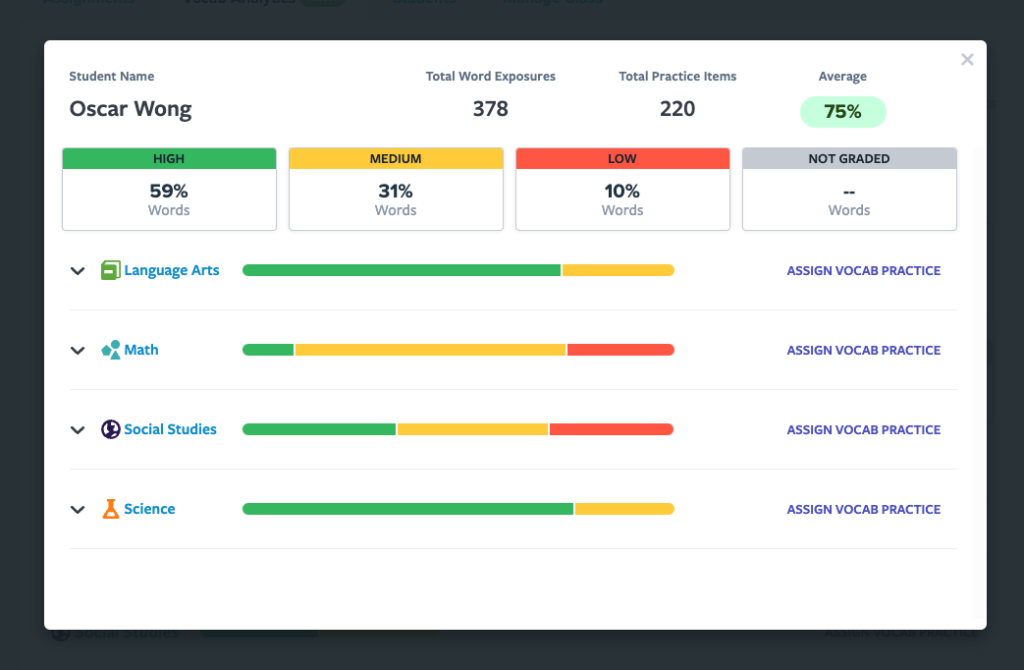
6 Tips for using the Vocab Analytics dashboard
1. Make it relevant and rigorous with data-backed instruction
Think about the “hard” teacher in your school growing up. What did that classroom look like? A stone-faced authority in the front with students quietly working in silos. Most students failed, and only an elite few “earned” the A’s. While the academic subject may have been rigorously taught, I’m sure many of you reading this article are having flashbacks to all-nighters and B’s. A classroom immersed in chaos is likely not the ideal environment, but can a classroom be raucous and still bring the same level of academic rigor this memory evokes?
Data-backed instruction informed by tools like the Vocab Analytics dashboard demonstrates the role that rigor and fun play in transformative outcomes for our students. The LEGO Foundation’s white paper about Learning Through Play stated, “Learning through play also involves being actively engaged. When children are immersed in the act of self-directed effort, are minds-on, and persist through distraction, we see benefits to learning.”
With this engagement comes comprehension strategies, and all three combined often lead to a rigorous learning experience for students. Shukla (2020) stated, “Fun and play in classroom learning reduce the rigidity of the curriculum, which allows more student autonomy. It gives the students a sense of control. People have an innate need for growth (self-determination theory), which comes easily if there is autonomy, relatability, and a sense of competence. Fun and play allow a student to maximize all 3.” Ultimately, the argument here is unambiguous: Fun and rigor in education must coexist.
How to leverage Vocab Analytics
Flocabulary brings fun and data-backed instruction informed by tools like the Vocab Analytics dashboard helps classroom educators ensure rigor. While navigating your Vocab Analytics tab, you can see the total number of students practicing vocabulary, as well as the percentage of students who are showing high, medium, and low levels of proficiency overall. You can also view the breakdown of students’ proficiency within each subject. Hover over the bars to see the number of students with an overall score in each category and a list of the top words that are trending high, medium, and low within each subject. These are perfect tools to prep for reinforcing the instruction your students need to excel, combined with the fun to keep their minds-on in the classroom.
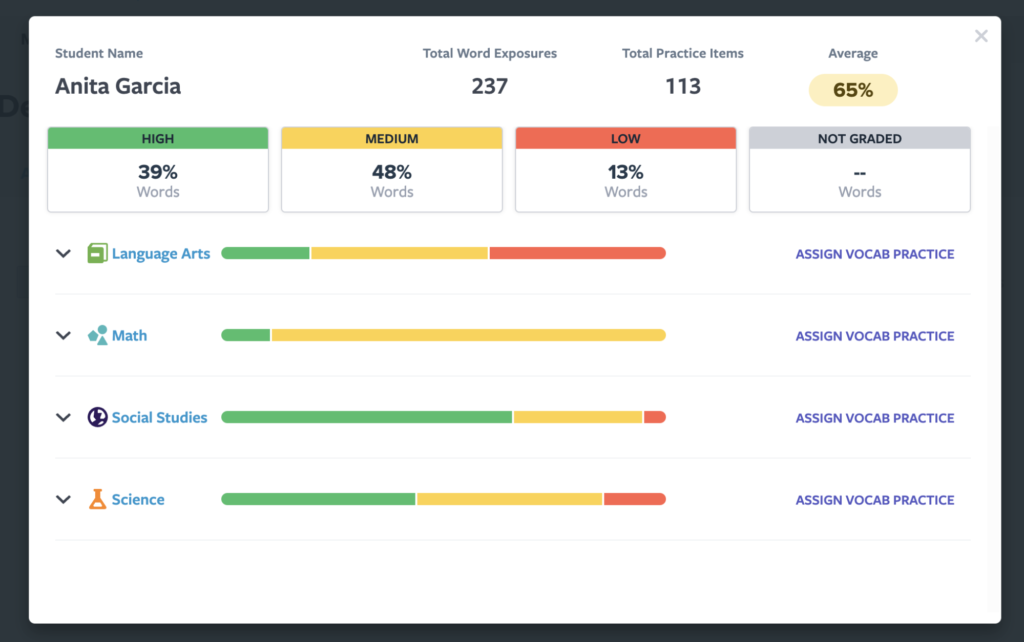
2. Incorporate active learning experiences
For students to learn, they need to be actively engaged, both in their classroom community and curriculum. As educator Zaretta Hammond explains, when students have made meaningful connections in the classroom—with the content, with their teacher, and with one another—their brains are better able to process new information. This, in turn, enables them to take on more rigorous work, as they are emotionally and psychologically prepared for the vulnerability that growth and learning require. This is why active learning experiences engage students and support learning. When supported by tools like the Data Analytics dashboard, students take their learning to the next level.
How teachers can leverage Vocab Analytics
Program coaches can make use of the immediate insights available on the Vocab Analytics tab to direct instruction for students across multiple buildings. In the Vocab Analytics tab, if you are a district manager, the metrics you see will reflect activity in your district as a whole. If you are a manager of a school within a district, the metrics will reflect your school’s activity.
Teachers can incorporate active learning experiences by:
- Encouraging students to take part in Flocabulary’s student contest in which winners have the opportunity to be featured in an official Flocabulary video
- Creating personalized vocabulary practice assignments based on a preferred academic subject
- Incorporating Flocabulary videos into choice boards embedded into Nearpod lessons
On the Word Exposure graph, you can see where Flocabulary is being implemented to impact students’ vocabulary in your district. As students watch Flocabulary videos and complete all of the additional activities (Vocab Cards, Vocab Game, Break It Down, Read & Respond, Quiz, and Lyric Lab), they gain more exposure to general academic and subject-specific vocabulary words. District admins can compare the number of exposures in all subjects side by side, or click on one of the subject names to view that subject independently. Hover over a month on the graph to view the number of exposures for each subject school year to date, as well as the number of exposures per topic within a subject and the change from the previous month. To boot, these insights can be regularly sent to your email, empowering you to make district decisions to support literacy in every building.

3. Apply insights to support classrooms and buildings alike
Data compilation and analysis on a building level is just as important, but now, you’re working with a much larger data set. Timeliness on this scale can make the difference in ensuring students are graduating and on the right path for their future—largely the measure of success for any district.
A research study from Bertram Opitz on delayed and immediate feedback found that immediate feedback contributes to a significantly larger increase in learning than delayed feedback. Educators face the same struggle: timely application of insights to guide their instruction. Nothing is more disheartening than grading a stack of papers two weeks after the fact only to realize your vocabulary instruction was ineffective. The answer? Real-time insights from tools like the Vocab Analytics dashboard.
How to leverage Vocab Analytics
Within the Vocab Analytics dashboard, you can see the total number of students practicing vocabulary, as well as the percentage of students who are showing high, medium, and low levels of proficiency overall. You can also view the breakdown of students’ proficiency within each subject. Hover over the bars to see the number of students with an overall score in each category and a list of the top words that are trending high, medium, and low within each subject.
Teachers and admins can improve instructional outcomes by implementing ideas such as:
- Creating targeted intervention groups based on the breakdown of students’ proficiency
- Use insights to develop lists of vocabulary words to reinforce based on the medium and low words ID’d on the dashboard
- Creating professional learning groups based on class-level data to help teachers in your building support each other
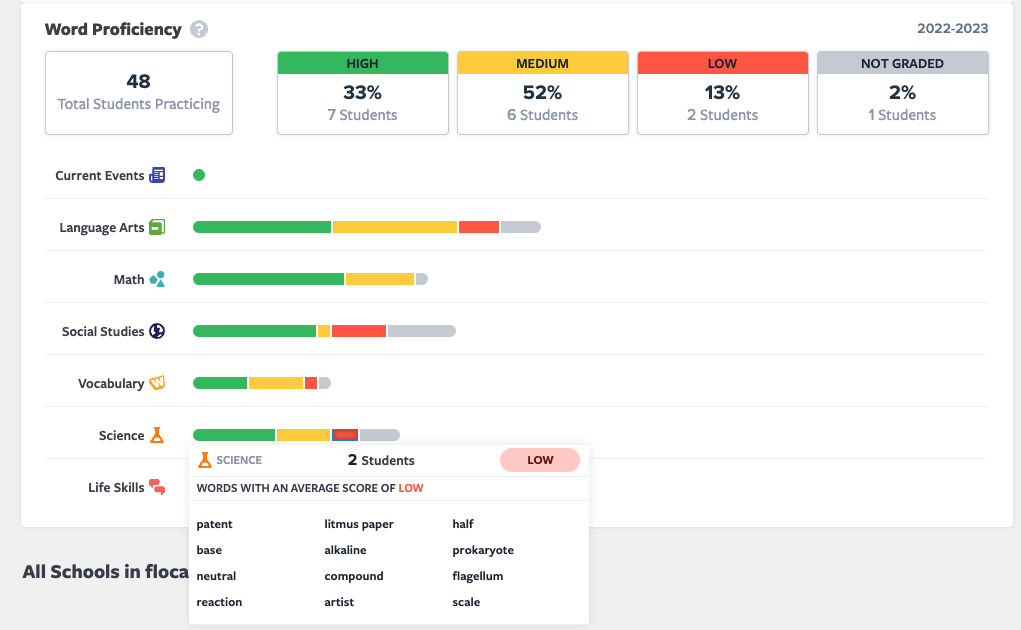
When supported by the right tools, you can build real-time insights right into what you’re already doing (which is a fabulous job) to identify gaps in understanding and support the students who need it in a time frame that effectively increases understanding.
4. Responsive instructional tools
Educators understand the importance of differentiating instruction based on multiple checks for understanding conducted within a lesson, across a school day, or even throughout an entire unit of study. Throughout the school day, teachers then can listen for clues as to how students are or are not building their understanding of vocabulary key to the academic topic.
How teachers can leverage Vocab Analytics
After those keen observations, it’s important for your instructional tools to be responsive to your students’ needs and make them actionable. Flocabulary’s Vocabulary Practice Sets are a great addition to any differentiation toolkit. Under any given subject in your dashboard, you can see which students have a low proficiency score. Simply click on “Assign Vocab Practice,” and that student will receive Vocab Flashcards, additional videos, and a customized Vocab Game featuring the 10 words that they need to practice most—all personalized without your having to create any additional content. These personalized Vocabulary Practice Sets provide a powerful tool to individualize instruction, supplying you with more data to inform your upcoming instruction.

This personalized approach extends to the accompanying Vocab Game, providing students with additional opportunities to reinforce understanding and improve proficiency scores. By leveraging this feature, teachers can effectively address learning gaps, customize instruction, and foster student mastery in vocabulary acquisition, without the need for customized content creation. Principals can also encourage teachers to utilize Vocab Practice Sets to support in delivering targeted instruction, promoting collaboration, and ensuring equitable access to high-quality education for all students.
Teachers can adapt their instruction to student needs by:
- Creating playlists for students grouped according to their proficiency
- Leveraging intervention and enrichment time by creating Vocab Practice Sets for individual students in need of support, giving them the opportunity to demonstrate mastery
- Better using individual data to support each student
Flocabulary Playlists
Support each student further by creating a Playlist built for your students and their needs. Playlists enable teachers to curate a set of Flocabulary videos to extend student learning. You can curate your own playlists by hand or using AI, and choose from a library of playlists curated by the Flocabulary team. All playlists, whether created by you or the Flocabulary team, will let you queue up a list of Flocabulary songs to play back to back.
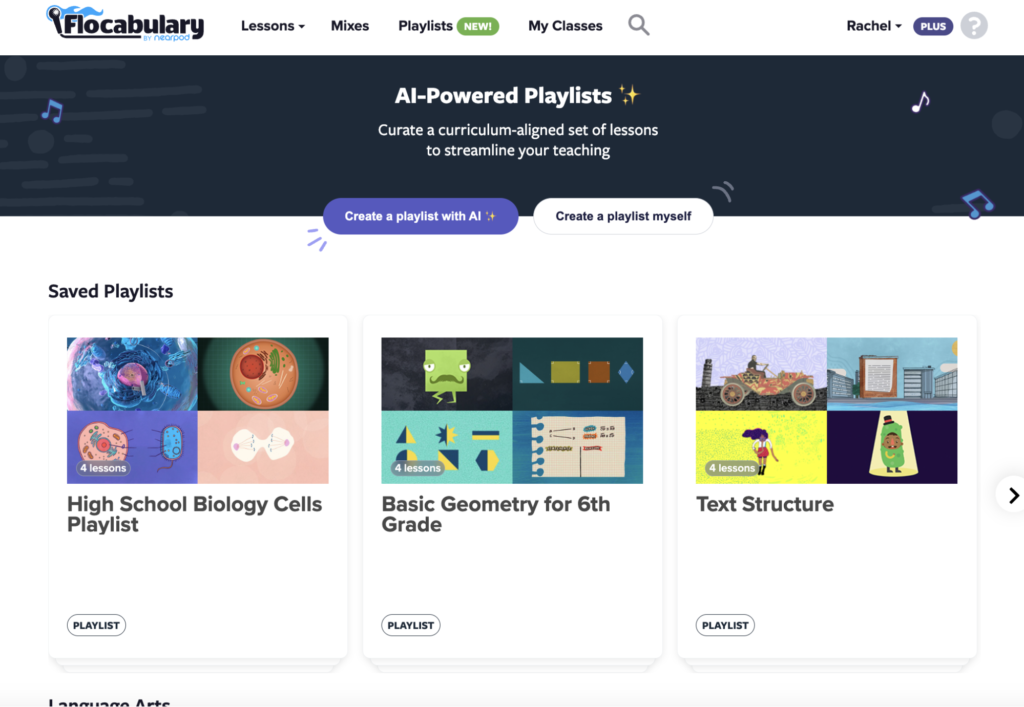
When supported by the right tools, you can build real-time insights right into what you’re already doing (which is a fabulous job) to identify gaps in understanding and support the students who need it in a time frame that effectively increases understanding.
5. Access to a plethora of pedagogically sound resources
Every teacher could write at least one book (or sometimes two or three) based on their experiences in the classroom. Material like that doesn’t appear because every student is the same. Any individual who has spent time in the classroom can tell you the universal truth: Every student is different. And that means no single resource will ever suit every single student. Access to a plethora of pedagogically sound resources is essential for seeing every student and supporting them in the way they need.
How teachers leverage Vocab Analytics
Flocabulary is equipped with a library of more than 1,300 standards-aligned hip-hop videos and lesson activities. With every lesson we create, our goal is to accelerate learning and vocabulary acquisition through genuinely rigorous and authentically engaging instructional experiences. Each lesson begins with an awesome curriculum writer, who reviews national and state standards, determines the proper grade range for a lesson, and identifies student learning objectives. This same individual is involved throughout the entire production process to ensure rigor, accuracy, and alignment to learning objectives. Since no two lessons (or students!) are exactly alike, our team often has to remain flexible to ensure that our approach best serves the topic being taught. This flexibility also helps us maintain a high bar for quality from a curriculum, audio, and visual perspective.
Teachers can verify the pedagogy behind a resource by looking for some key variables:
- Does it engage students’ higher-order thinking skills by crafting questions that challenge kids to apply, analyze, and evaluate?
- Does it guide and support kids to push beyond basic comprehension skills?
- Does it engage student creativity to address the pinnacle skill of Bloom’s Taxonomy to demonstrate mastery: CREATE?
There are many reasons why principals love Flocabulary, but the variety of resources students love backed by an expert curriculum team is at the top of the list.
6. Identify and support transformative instruction
Data is for more than just students; it helps us reflect on how and what we’re teaching. And the right tools help us analyze that data to elevate instruction. Centrally identifying what’s working enables district admins to identify and support transformative instruction and further expand those practices to other classrooms. This is a great place to apply the Vocab Analytics dashboard built into Flocabulary. Using this tool, you can identify transformative instructional practices happening in your buildings, and apply them to the larger scope.
How administrators can leverage Vocab Analytics
Administrators can improve district outcomes by implementing ideas such as:
- Compare buildings across the district and review differences in implementation
- Look across departments to determine if different teachers have strengths they could share with their peers, to ensure all students benefit from the great ideas in your classrooms
- Use the data gathered to guide your district’s professional development and policy to better support both the students and staff working so hard in your building daily
The school’s table on the district dashboard enables administrators to compare Flocabulary implementations across schools to identify campuses maximizing the impact of Flocabulary. View the list of active schools in your district and assess the amount of word exposure and practice and word proficiency for each. Sort alphabetically by school or by average score.
Click on a school in the table or in the dropdown at the top of the dashboard to access the individual dashboard for each school within the district. On the school dashboard, you can view all metrics for word exposure, practice, and proficiency at the school level. If you are a manager of a school within a district, this dashboard will be your default view.
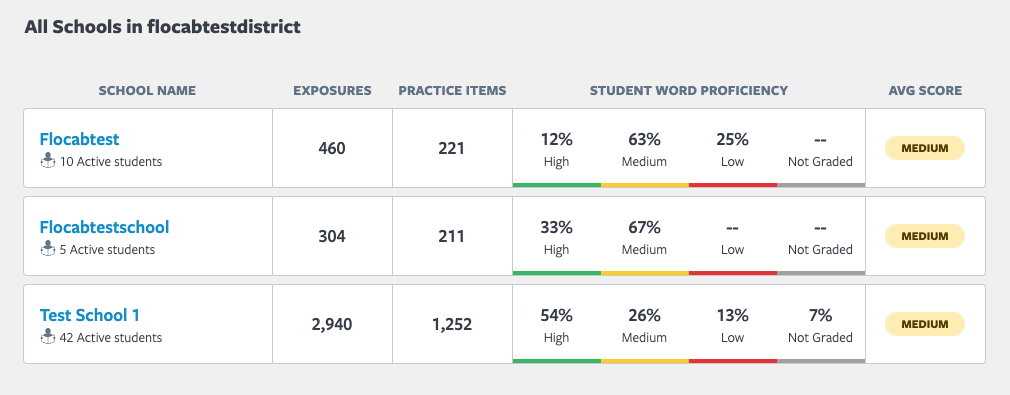
View the classes table to compare Flocabulary implementations across classes and identify teachers with best practices for implementing Flocabulary that can be applied across the school or district. Filter down to the grade levels and subjects you’re interested in assessing, or sort by educator or average score.
Reviewing the data available in the Vocab Dashboard gives you an opportunity to identify which classrooms are successfully supporting vocabulary instruction. Identifying effective instructors means elevating these educators during district PD days and giving them the opportunity to lead professional learning groups and share their effective methods with others in the building.
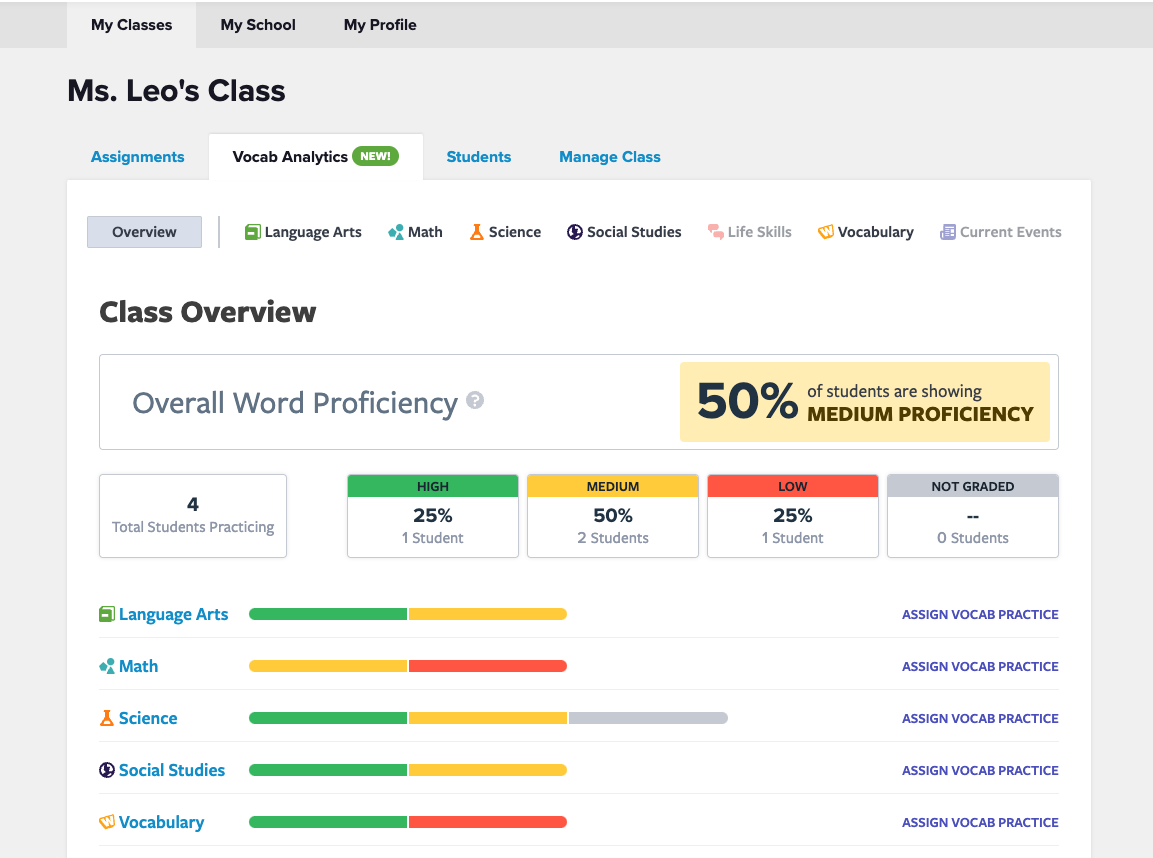
Visual outputs like the Flocabulary Dashboard streamline the sharing and implementation of these best practices. By comparing Flocabulary implementations across schools and classes, administrators can identify campuses, grade levels, and educators who are maximizing the impact of Flocabulary. Take the next step by gathering best practices to share with the rest of the school or district and assessing the level of word proficiency at each school and within each class, thereby identifying areas of strength and students needing intervention.
Start using the Vocab Analytics dashboard
Vocabulary knowledge is paramount to reading comprehension. When students don’t know what words mean, it becomes a barrier to their understanding of the text and can quickly hinder their learning experience across the curriculum. However, barriers to effective instruction can threaten this foundational skill. By utilizing engaging instructional experiences students love, real-time insights to tailor instruction, centralized quality tools, and supporting transformative practices on a district scale, educators in the classroom, building, and district can make a difference for every student. When teachers and administrators understand how to navigate and leverage the Vocab Analytics dashboard built into Flocabulary, students learn, educators excel, and communities transform.
New to Flocabulary? Teachers can sign up for a trial to access our lesson videos and assessment activities. Administrators can get in touch with us to learn more about unlocking the full power of Flocabulary through Flocabulary Plus.
